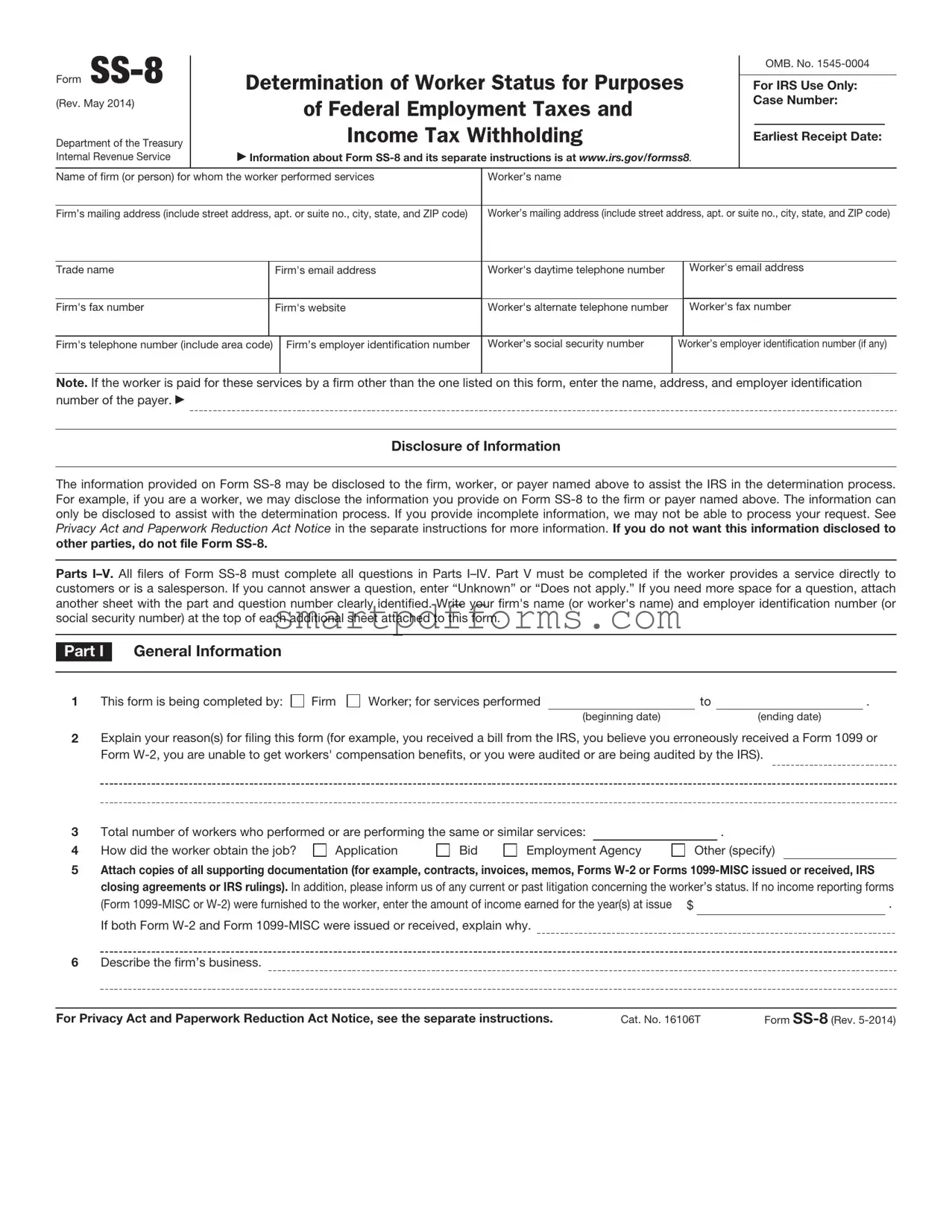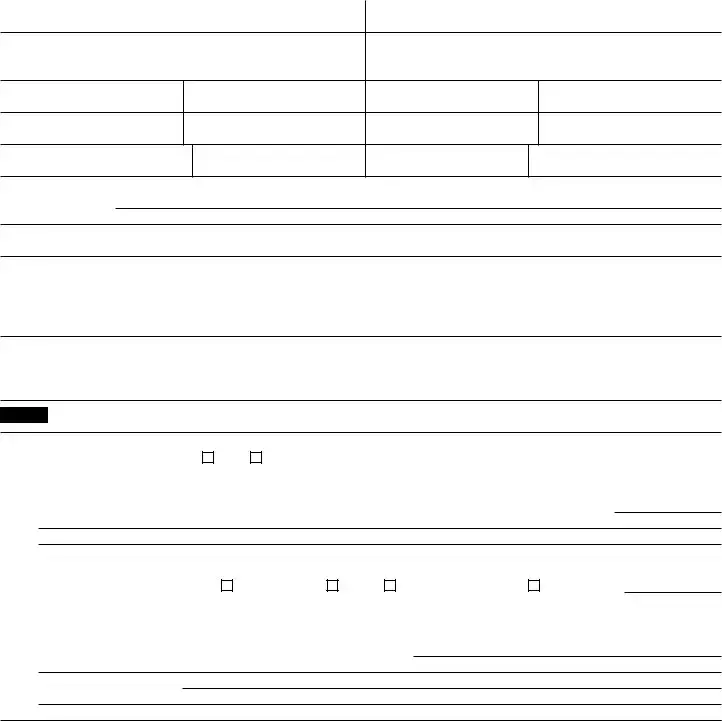Form SS-8 |
Determination of Worker Status for Purposes |
|
OMB. No. 1545-0004 |
|
|
|
For IRS Use Only: |
|
(Rev. May 2014) |
of Federal Employment Taxes and |
Case Number: |
|
|
|
|
|
|
Income Tax Withholding |
|
|
|
Department of the Treasury |
Earliest Receipt Date: |
|
Internal Revenue Service |
Information about Form SS-8 and its separate instructions is at www.irs.gov/formss8. |
|
|
|
|
|
|
|
|
|
Name of firm (or person) for whom the worker performed services |
Worker’s name |
|
|
|
Firm’s mailing address (include street address, apt. or suite no., city, state, and ZIP code)
Worker’s mailing address (include street address, apt. or suite no., city, state, and ZIP code)
Worker's daytime telephone number
Worker's alternate telephone number
Firm's telephone number (include area code)
Firm’s employer identification number
Worker’s social security number
Worker’s employer identification number (if any)
Note. If the worker is paid for these services by a firm other than the one listed on this form, enter the name, address, and employer identification number of the payer.
Disclosure of Information
The information provided on Form SS-8 may be disclosed to the firm, worker, or payer named above to assist the IRS in the determination process. For example, if you are a worker, we may disclose the information you provide on Form SS-8 to the firm or payer named above. The information can only be disclosed to assist with the determination process. If you provide incomplete information, we may not be able to process your request. See Privacy Act and Paperwork Reduction Act Notice in the separate instructions for more information. If you do not want this information disclosed to other parties, do not file Form SS-8.
Parts I–V. All filers of Form SS-8 must complete all questions in Parts I–IV. Part V must be completed if the worker provides a service directly to customers or is a salesperson. If you cannot answer a question, enter “Unknown” or “Does not apply.” If you need more space for a question, attach another sheet with the part and question number clearly identified. Write your firm's name (or worker's name) and employer identification number (or social security number) at the top of each additional sheet attached to this form.
Part I General Information
1This form is being completed by:
Worker; for services performed |
|
to |
|
. |
|
(beginning date) |
|
(ending date) |
2Explain your reason(s) for filing this form (for example, you received a bill from the IRS, you believe you erroneously received a Form 1099 or Form W-2, you are unable to get workers' compensation benefits, or you were audited or are being audited by the IRS).
|
|
|
|
|
|
|
|
3 |
Total number of workers who performed or are performing the same or similar services: |
|
|
. |
4 |
How did the worker obtain the job? |
Application |
Bid |
Employment Agency |
Other (specify) |
5Attach copies of all supporting documentation (for example, contracts, invoices, memos, Forms W-2 or Forms 1099-MISC issued or received, IRS closing agreements or IRS rulings). In addition, please inform us of any current or past litigation concerning the worker’s status. If no income reporting forms
|
(Form 1099-MISC or W-2) were furnished to the worker, enter the amount of income earned for the year(s) at issue $ |
. |
|
If both Form W-2 and Form 1099-MISC were issued or received, explain why. |
|
|
6 |
Describe the firm’s business. |
|
|
For Privacy Act and Paperwork Reduction Act Notice, see the separate instructions. |
Cat. No. 16106T |
Form SS-8 (Rev. 5-2014) |
Form SS-8 (Rev. 5-2014) |
Page 2 |
Part I General Information (continued)
7If the worker received pay from more than one entity because of an event such as the sale, merger, acquisition, or reorganization of the firm for whom the services are performed, provide the following: Name of the firm's previous owner:
Previous owner's taxpayer identification number: |
Change was a: |
Sale |
Merger |
Acquisition |
Reorganization |
Other (specify) |
|
|
|
|
|
Description of above change: |
|
|
|
|
|
Date of change (MM/DD/YY):
8Describe the work done by the worker and provide the worker’s job title.
9Explain why you believe the worker is an employee or an independent contractor.
10Did the worker perform services for the firm in any capacity before providing the services that are the subject of this determination request?
If “Yes,” what were the dates of the prior service?
If “Yes,” explain the differences, if any, between the current and prior service.
11If the work is done under a written agreement between the firm and the worker, attach a copy (preferably signed by both parties). Describe the terms and conditions of the work arrangement.
Part II Behavioral Control (Provide names and titles of specific individuals, if applicable.)
1What specific training and/or instruction is the worker given by the firm?
2How does the worker receive work assignments?
3Who determines the methods by which the assignments are performed?
4Who is the worker required to contact if problems or complaints arise and who is responsible for their resolution?
5What types of reports are required from the worker? Attach examples.
6Describe the worker’s daily routine such as his or her schedule or hours.
7At what location(s) does the worker perform services (for example, firm’s premises, own shop or office, home, customer’s location)? Indicate the appropriate percentage of time the worker spends in each location, if more than one.
8Describe any meetings the worker is required to attend and any penalties for not attending (for example, sales meetings, monthly meetings, staff meetings).
9 |
Is the worker required to provide the services personally? |
Yes |
No |
10If substitutes or helpers are needed, who hires them?
11 |
If the worker hires the substitutes or helpers, is approval required? |
Yes |
No |
|
If “Yes,” by whom? |
|
|
12Who pays the substitutes or helpers?
13 |
Is the worker reimbursed if the worker pays the substitutes or helpers? |
Yes |
No |
|
If “Yes,” by whom? |
|
|
Form SS-8 (Rev. 5-2014) |
Page 3 |
Part III Financial Control (Provide names and titles of specific individuals, if applicable.)
1List the supplies, equipment, materials, and property provided by each party: The firm:
The worker:
Other party:
2 Does the worker lease equipment, space, or a facility? . . . . . . . . . . . . . . . . . . . .
If “Yes,” what are the terms of the lease? (Attach a copy or explanatory statement.)
3What expenses are incurred by the worker in the performance of services for the firm?
4Specify which, if any, expenses are reimbursed by: The firm:
|
Other party: |
|
|
|
|
|
|
|
5 |
Type of pay the worker receives: |
Salary |
Commission |
Hourly Wage |
Piece Work |
|
|
Lump Sum |
Other (specify) |
|
|
|
|
|
|
If type of pay is commission, and the firm guarantees a minimum amount of pay, specify amount. $ |
|
|
|
6 |
Is the worker allowed a drawing account for advances? |
Yes |
No |
|
If “Yes,” how often? |
|
|
|
|
|
|
|
|
Specify any restrictions. |
|
|
|
|
|
|
|
7 |
Whom does the customer pay? |
. . . . . . |
Firm |
|
If worker, does the worker pay the total amount to the firm? |
Yes |
No If |
“No,” explain. |
8 |
Does the firm carry workers' compensation insurance on the worker? |
Yes |
No |
9What economic loss or financial risk, if any, can the worker incur beyond the normal loss of salary (for example, loss or damage of equipment, material)?
10 |
Does the worker establish the level of payment for the services provided or the products sold? |
|
If “No,” who does? |
Part IV |
Relationship of the Worker and Firm |
|
|
|
|
|
|
|
|
|
|
|
|
1 |
Please check the benefits available to the worker: |
Paid vacations |
Sick pay |
Paid holidays |
|
|
|
Personal days |
Pensions |
|
Insurance benefits |
Bonuses |
|
|
|
Other (specify) |
|
|
|
|
|
2 |
Can the relationship be terminated by either party without incurring liability or penalty? |
Yes |
No |
|
If “No,” explain your answer. |
|
|
|
|
|
3 |
Did the worker perform similar services for others during the time period entered in Part I, line 1? |
Yes |
No |
|
If “Yes,” is the worker required to get approval from the firm? |
Yes |
No |
4Describe any agreements prohibiting competition between the worker and the firm while the worker is performing services or during any later period. Attach any available documentation.
5 Is the worker a member of a union? |
Yes |
6What type of advertising, if any, does the worker do (for example, a business listing in a directory or business cards)? Provide copies, if applicable.
7If the worker assembles or processes a product at home, who provides the materials and instructions or pattern?
8What does the worker do with the finished product (for example, return it to the firm, provide it to another party, or sell it)?
9How does the firm represent the worker to its customers (for example, employee, partner, representative, or contractor), and under whose business name does the worker perform these services?
10If the worker no longer performs services for the firm, how did the relationship end (for example, worker quit or was fired, job completed, contract ended, firm or worker went out of business)?
Form SS-8 (Rev. 5-2014) |
Page 4 |
Part V For Service Providers or Salespersons. Complete this part if the worker provided a service directly to customers or is a salesperson.
1What are the worker’s responsibilities in soliciting new customers?
2Who provides the worker with leads to prospective customers?
3Describe any reporting requirements pertaining to the leads.
4What terms and conditions of sale, if any, are required by the firm?
5 Are orders submitted to and subject to approval by the firm? . . . . . . . . . . . . . . . . . .
6Who determines the worker’s territory?
7 |
Did the worker pay for the privilege of serving customers on the route or in the territory? |
|
If “Yes,” whom did the worker pay? |
|
If “Yes,” how much did the worker pay? . . . . . . . . . . . . . . . . . . . . . $ |
8Where does the worker sell the product (for example, in a home, retail establishment)?
9List the product and/or services distributed by the worker (for example, meat, vegetables, fruit, bakery products, beverages, or laundry or dry cleaning services). If more than one type of product and/or service is distributed, specify the principal one.
10 |
Does the worker sell life insurance full time? |
11 |
Does the worker sell other types of insurance for the firm? |
|
If “Yes,” enter the percentage of the worker’s total working time spent in selling other types of insurance |
12If the worker solicits orders from wholesalers, retailers, contractors, or operators of hotels, restaurants, or other similar
establishments, enter the percentage of the worker’s time spent in the solicitation . . . . . . . . . . . .
13Is the merchandise purchased by the customers for resale or use in their business operations? . . . . . . . .
Describe the merchandise and state whether it is equipment installed on the customers’ premises.
Under penalties of perjury, I declare that I have examined this request, including accompanying documents, and to the best of my knowledge and belief, the facts presented are true, correct, and complete.
F |
|
Title |
|
Date |
|
|
|
|
|
|
|
|
|
Type or print name below signature. |
|
|




